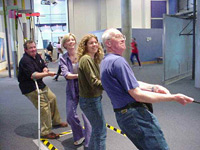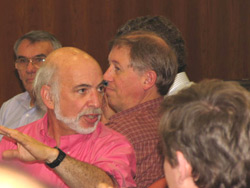Director's Corner
1 February 2007
 Barry Barish |
The Evolving ILC Design: Push-Pull Detector Arrangement
"The full realization of the scientific potential of the ILC argues for the construction and operation of two complementary detectors by two international collaborations." This statement comes from a chapter of the soon to be released ILC Detector Concept Report (DCR), and there are many arguments for having two detectors. They would maximise the scientific opportunities, give the opportunity to cross-check, and provide complementarity and reliability. The case is backed up by generations of successful historical examples in particle physics. Designing the ILC to accommodate two complementary detectors has been a fundamental precept of our design process. As we have optimised the ILC for cost–to-performance, we have made no changes that reduce the scope of the physics potential. In the beam delivery and detector areas, we have changed the crossing angle to 14 mrad to reduce risk and cost; we have reduced the muon shield to the calculated thickness while preserving the option of increasing the shielding if necessary; we have moved the detector assembly to the surface to ease scheduling issues, and finally this week the Executive Committee decided to go to a "push-pull" detector arrangement for our Reference Design.
 A well- engineered modern "push-pull" system will let two sophisticated ILC detectors share a single interaction point. |
 Marty Breidenbach responds to a push-pull feasibility question at the GDE Valencia meeting. |
In the original baseline configuration, we planned for two beamlines servicing two detectors placed at two different interaction points. However, once we obtained costing information, it became apparent that the beam lines are very expensive and comparable to the cost of the detectors. For that reason, we initiated a study last September to check whether eliminating one beam line and sharing a single interaction region was an option. The study group included representatives of the various detector concepts under development, as well as the ILC beam delivery group and other technical experts. A detailed report of the findings was reported by Andrei Seryi at the Valencia meeting last November. He concluded that there are large cost savings if we could make do with one beamline and that it appears feasible to alternate detectors within one week, and that no technical "show stoppers" had been uncovered. However, he pointed out that more detailed engineering will be required to prove and develop this concept.
We broadly sought discussions with and input from the ILC experimenters. The ILCSC Parameters Group was asked to comment on this proposed change and they concluded that "switching between experiments should be accomplished with less than a few percent loss of integrated luminosity. If necessary for design and cost considerations, the two experiments could share a common IR, provided that the detector changeover can be accomplished in approximately 1 week." Each of the experimental concepts was asked to participate in the study and to give input regarding the impact of this potential change on their concept. They all emphasised the need for rapid changeover (in the order of or less than one week), and many of them stated reservations or caution until seeing proof that final engineering of the "push-pull" concept is feasible. In addition, the Machine-Detector Interface (MDI) group together with the World Wide Study (WWS) urged us to keep the option for two interaction regions alive as an alternative, if we change the baseline.
The Change Control Board received a change request from Andrei Seryi on 29 November and made their recommendation to the GDE Executive Committee on 23 December. They recommended that we accept the change request, concurring with the experimenters’ request that the two-IR option be kept as an alternative to the baseline and that a new taskforce be charged by both the GDE and WWS to facilitate the future design efforts. The Executive Committee has approved the basic recommendation to change the baseline and the "push-pull" configuration has been adopted as the configuration in the Reference Design Report and Costing. The two-IR option will be carried as an alternative. The GDE will reorganise itself over the coming months to prepare for the engineering design phase, but we anticipate that we will form a group with the WWS to guide the engineering design of the push-pull system.
Finally, I would like to add my personal view that the push-pull concept, although creating an extra set of issues and challenges for the experiments, promises a cost-effective concept for the experimental areas that will enable us to develop two detectors for the ILC science programme.
-- Barry Barish